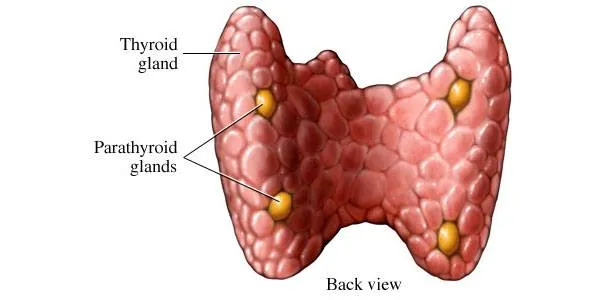Parathyroid Gland Funcion, Definition and Facts
A number of vital functions in human body are controlled by biochemical substances, called hormones, which are chemical messengers released by either ductless or ducted glands directly into the blood stream or through ducts.
Of all the hormone secreting glands in the body, the parathyroid gland is the smallest which is embedded in the thyroid gland or located on the rear side of it in the neck.
There are four parathyroid glands located on the posterior side of the thyroid, measuring only about the size of a rice grain.

Because of the very small size, these endocrine glands weigh as low as 20mg or as high as 40mg. Usually, these are four in number, arranged in two pairs-one above and the other below-but some individuals have also been reported to have 6, 8 or even more.
The two glands lying towards the head are termed as the superior parathyroid glands, while the other two lying on the lower side are known as the inferior parathyroid glands.
Though the parathyroid glands are named after their close proximity with the thyroid gland, their functions are completely different from that of the neighbouring endocrine organ.
Nervous and muscular systems are very sensitive to the concentration of calcium in the body that has to be maintained in a narrow range for their proper functioning.
The hormone secreted by parathyroid gland (named after the gland as 'parathyroid hormone' or simply "parathormone") is responsible for the maintenance of phosphate and calcium homeostasis in the body, and is functionally opposed to calcitonin.
Fun Facts on Parathyroid Glands
- Though there are no pills or medications to cure the diseases of parathyroid gland, surgery and some other treatment measures have shown promising results.
- Most of the parathyroid problems present themselves in their advanced stages, and some patients will not complain of any symptoms, until they are identified during routine diagnostic procedures.
- Often the medical fraternity get confused with the diseases of the parathyroid gland and the blood calcium levels, as neither of these the conditions (diseases and calcium levels) have ever been found to synchronize with each other.
- Most of the patients suffering from parathyroid disease have fluctuating blood calcium levels both in blood and bony structures.
- Almost all people with hyperparathyroidism, i.e., excessive secretion of the parathyroid hormone develop osteoporosis or the break bone disease. And most of the drugs designed for osteoporosis are not found to show any signs of recovery in these patients.
- No miraculous improvement or treatment strategies have ever been invented to perfectly deal with parathyroid disease, and for most patients, the disease gets worse day by day even with medications.
- Though surgery is one of the best treatment options, but the success rates of these surgeries depend on the competence of the surgeon and severity of the condition.
Functions
The main function of the Parathyroid gland is to control the blood calcium levels within the range of 9-10 mg/dl which is done by the gastrointestinal absorption of calcium and its conservation in kidneys.
It stimulates absorption of calcium from food and restricts kidneys from excreting excessive calcium in urine.
If the blood calcium levels are low, the hormone would erode the bones to manage optimal blood calcium levels, thus making the bones weak and easily breakable.
The gland also checks and regulates the levels of calcium deposition on the bones and their density.
Calcium not just makes the density of the bones and frames the skeletal system of the body, but is also vital to regulate and mediate nerve conduction and control of muscular activities (muscle contraction and relaxation).
The electrical signals travelling from the tissues towards the master organ of the body (brain) are mediated with the help of calcium ions.
The people who have blood calcium levels below the normal limits experience a sensation of prickling or extra-chill in their fingers along with severe muscular cramps in their legs.
Diseases of the Parathyroid Gland
Hypo-Parathyroidism
The parathormone (or parathyroid hormone) synthesised and secreted in insufficient quantities, consequently, results in abnormally decreased blood calcium levels.
The condition expresses itself through frequent twitching and periodic spasms & tremors in the muscles, and such an abnormal state is known as tetany.
The most predominant causes of tetany include the development of tumours and failure in the surgical operations of thyroid and parathyroid glands.
One of the effective remedies is to treat the victim with calcium and vitamin D supplements where later is activated by the former.
Hyper-Parathyroidism
Over production of the hormone can be due to the development of tumours in parathyroid gland, in which the level of calcium in the blood rises and the victims are reported to have symptoms such as constipation and vomiting and formation of kidney stones.
Surgery of the affected gland is often regarded as the best available treatment measure as medications often fail to show any positive results under such conditions.
Parathyroid Cancers
It is quite rare for parathyroid gland to get cancerous or develop cancerous tumours, but if this is the case, the condition presents itself by the secretion of excessive amounts of parathyroid hormone that is released in the blood.
The cancerous cells are triggered to produce massive amount of the hormone and surgical removal of the gland could alone solve the chore.


